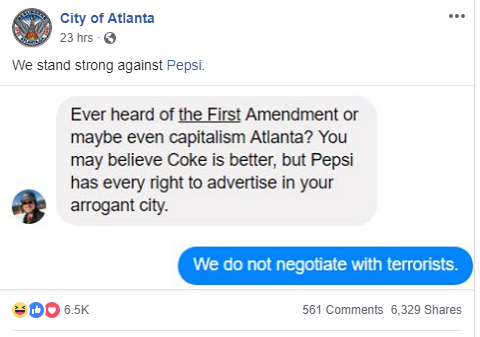Super Bowl 2019: Brands Defending Their Home Turf
The last time there was a battle near Atlanta, the city ended up in flames. This time, a blue wave washed over Atlanta for the Super Bowl LIII weekend. In the weeks leading up to the Super Bowl, Pepsi took over Coca-Cola’s turf, along with other foes to Atlanta-native brands, made their presence known.
While some fans watched the big league championship game between the New England Patriots and the Los Angeles Rams, others anticipated the extravagant halftime show and clever TV commercials (like Bud Light’s previous “Dilly Dilly” beer campaign or the Avocados from Mexico spot). But all of that excitement could not compare to the Atlanta brand turf war - aka the drama of Pepsi, FedEx, McDonald’s, Ford, Marriott and Sleep Number sponsoring the ATLANTA Super Bowl instead of local Atlanta brands like Coca-Cola, UPS, Chick-fil-A, Kia, Mercedes-Benz, IHG and Serta Simmons. Marketers and consumers everywhere watched the drama ensue.
How does a brand respond to such monstrosities when their hometown, their sanctuary, is quickly overtaken by competitors?
Tactic #1: Ignore the haters.
To be fair, there wasn’t THAT much drama between all of the brands. In fact, most Atlanta- native brands took the approach of being the “bigger person” and did not engage with their rivals’ competitive spirit. Intercontinental Hotel Group (IHG) and Chick-fil-A’s twitter behaviors were rather normal on the days leading up to the big game, only announcing news related to their own business.
Chick-fil-A, in fact, stuck to their guns and kept their policy in place on Super Bowl Sunday by closing their stands. Chick-fil-A did not deem McDonald’s a large enough problem to increase their marketing spend on ads. If McDonald’s had encroached on Burger King’s territory, however, it would have been a different situation. During all of the Super Bowl hype, Burger King still managed to find a way to knock down McDonald’s with their parody of Big Mac menu items.
So brands can decide if 1) the competitor is truly worth their time or 2) meddling or trolling the competitor aligns with the brand’s voice. In Chick-fil-A’s case, meddling was not.
No competitor was as boisterous as Pepsi who flaunted their Atlanta arrival with over 350 ads on billboards and Marta stations across the city. While this enraged Atlanta civilians (including a parody account titled “City of Atlanta”), Coca-Cola seemed surprisingly uninterested!
Pepsi generated a lot of buzz with their snarky billboard ads and Super Bowl TV commercial teaser featuring celebrities like Cardi B, Lil Jon and Steve Carell. This strategy drove more than 51,600 mentions of Pepsi on social media. Leading up to the Super Bowl, Pepsi was winning in the social media mention battle (282,000 Pepsi mentions vs 181,000 Coke mentions) and the engagement battle (1,8 million Pepsi shares/retweets vs 1,5 million Coke shares/retweets).
Luckily, Atlanta natives had Coke’s back…
Tactic #2: If the enemy persists, kill them with kindness.
When the intruder continues to throw punches, sometimes a kind response is stronger than an aggressive one. There is no doubt that Pepsi’s snarky campaign was intended to start a brand battle - but Coke refused to engage. Instead, Coca-Cola simply responded to their arrival by stating to CNN, "As Atlanta's hometown beverage company for more than 130 years, we're thrilled to help our city welcome everyone to town for the Big Game, including our friends from Pepsi.”
Pepsi did not hold back, however. In addition to having several Pepsi displays throughout the city and an active Twitter presence, Pepsi brought a statue of their own founder, Caleb Bradham, to “toast” John Pemberton, Coca-Cola’s founder.
Here is some of the correspondence between the brands on social media:
When the statue first appeared, Coca-Cola spokeswoman, Kate Hartman, reported that, “We are going to welcome them with a Coke and a smile.”
But before Coca-Cola could make a move, Pepsi removed the statue and blamed it on Coca-Cola for having a “cold shoulder” and tweeted, “Hey @CocaCola we swung by but it looks like you weren’t into having us over today…that doesn’t feel very #TogetherIsBeautiful.”
Coca-Cola donated $1 million to Atlanta's National Center for Civil and Human Rights to provide free admission to patrons through February. This act of unity may have been a response to Pepsi’s invasion, but it also tied into Coca-Cola’s Super Bowl campaign #TogetherIsBeautiful.
Though consumers are fond of brand battles on social media (like those of Wendy’s or Burger King), Pepsi attempted a different approach to gain traction on January 30th by partnering with United Way ATL and offering a free meal to those in need for every retweet.
Instead of spending money on roasting each other, the two brands killed each other with kindness to help the community.
Tactic #3: Learn to coexist.
At the end of the day, serving the consumer is all that matters - and no amount of bickering will change that.
There are Coca-Cola people and there are Pepsi people - and no single ad campaign will change a person’s allegiance. If anything, it was an opportunity for a rowdy publicity stunt. This “battle of the brands” showed just how important marketing efforts and social media can be in a public relations campaign. If Pepsi hadn’t had their Twitter to stir the pot and share the news about their statue, quippy remarks, or their charity efforts, no one would have even cared. This is a lesson for brands to utilize every resource in a battle and seize every moment as an opportunity - even if that means bringing your founder’s statue to your competitor’s turf.
Although many Atlanta brands were not front and center during Super Bowl LIII, having a major event in Atlanta helped boost the brands native to the city. Coca-Cola hosted a Champion Chat with former NFL players, “Mean” Joe Greene and Carl Banks, in the new football exhibit at the World of Coca-Cola and IHG hotels held special Super Bowl events around Buckhead where they served Coca-Cola.
While all of this feuding jolted the Atlanta community during the biggest football game of the season, it’s all in the competitive spirit of the Super Bowl. If anything, brand loyalists really stepped up to defend their homeland. AgencySparks is definitely against taking a side, but Pemberton would be proud of the tall Coca-Cola billboard that stands outside our office.

















Over the past year, we’ve watched the following patterns emerge across seemingly unrelated sectors: rising consumer expectations, demand for authenticity, growing complexity, and the tension between automation and human connection.
We interviewed multiple marketers from an array of industries in our blogs below, and we discovered consistent trends across the board. Check out all of our industry blogs throughout 2025 from leaders at Blackbaud, Hiscox USA, Mimedx, MONPURE, Kimberly-Clark Professional, and more.